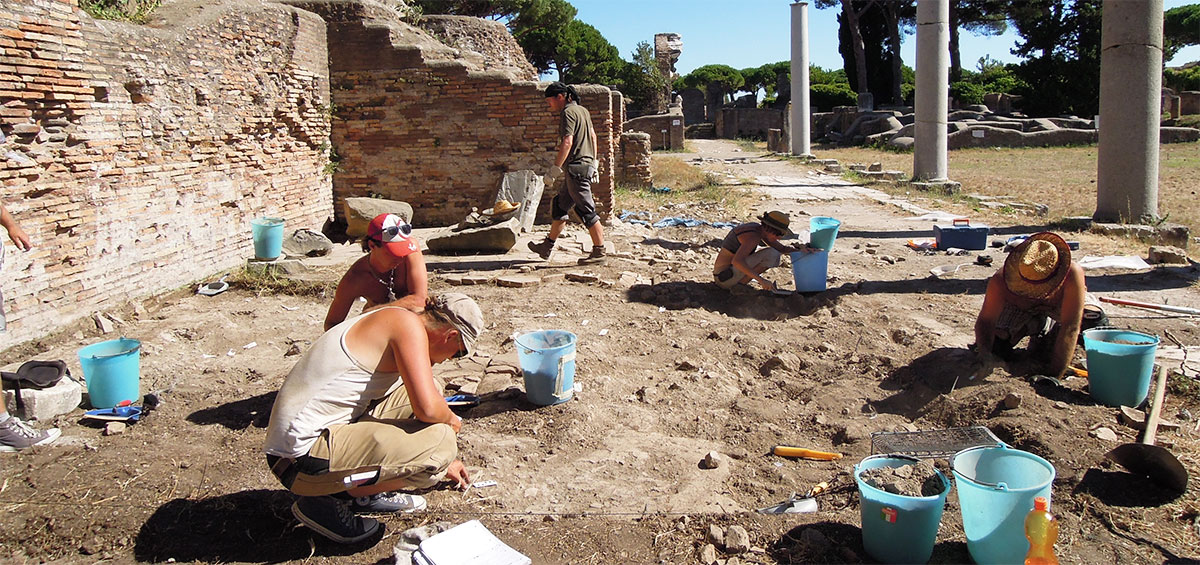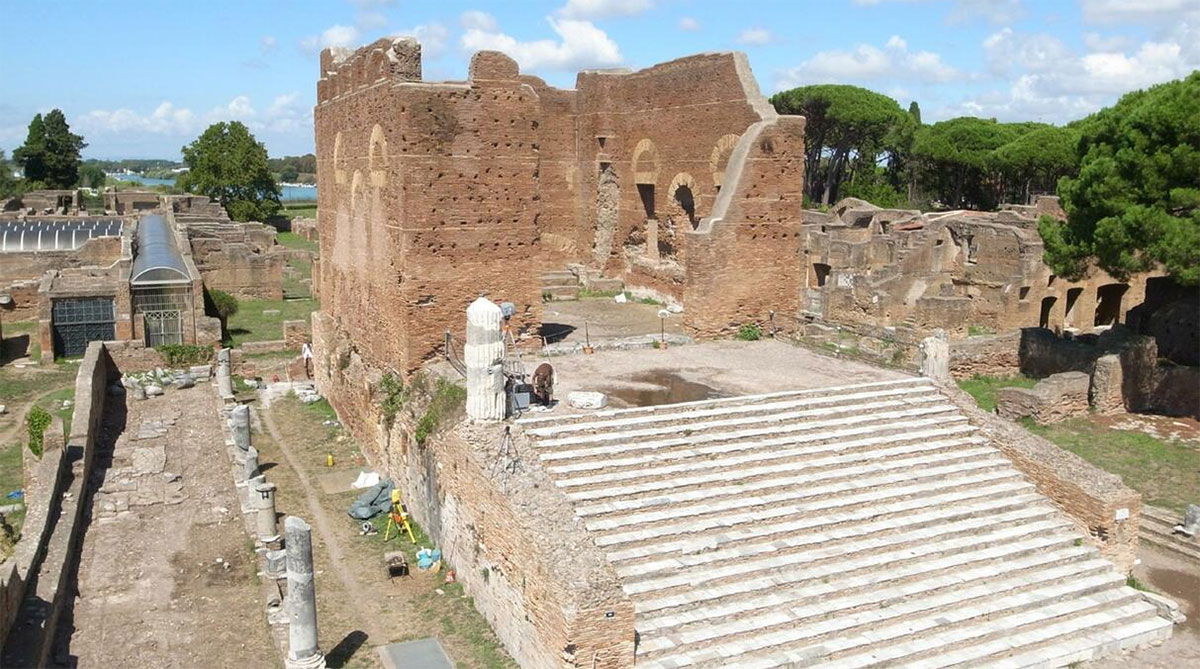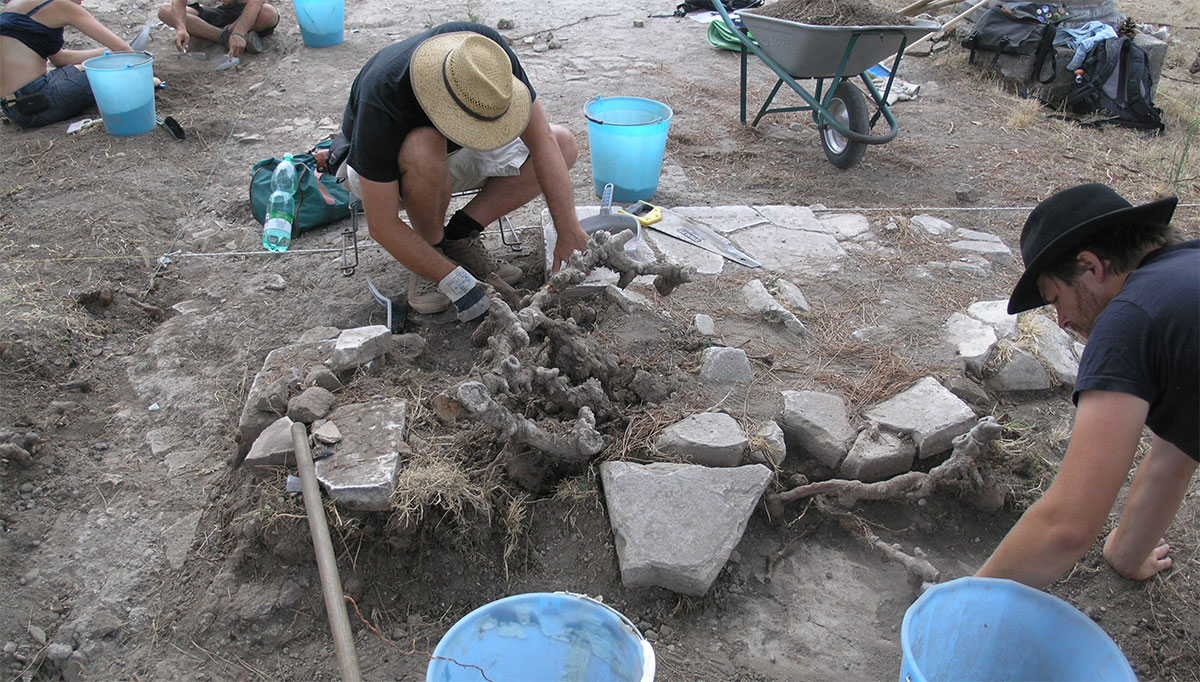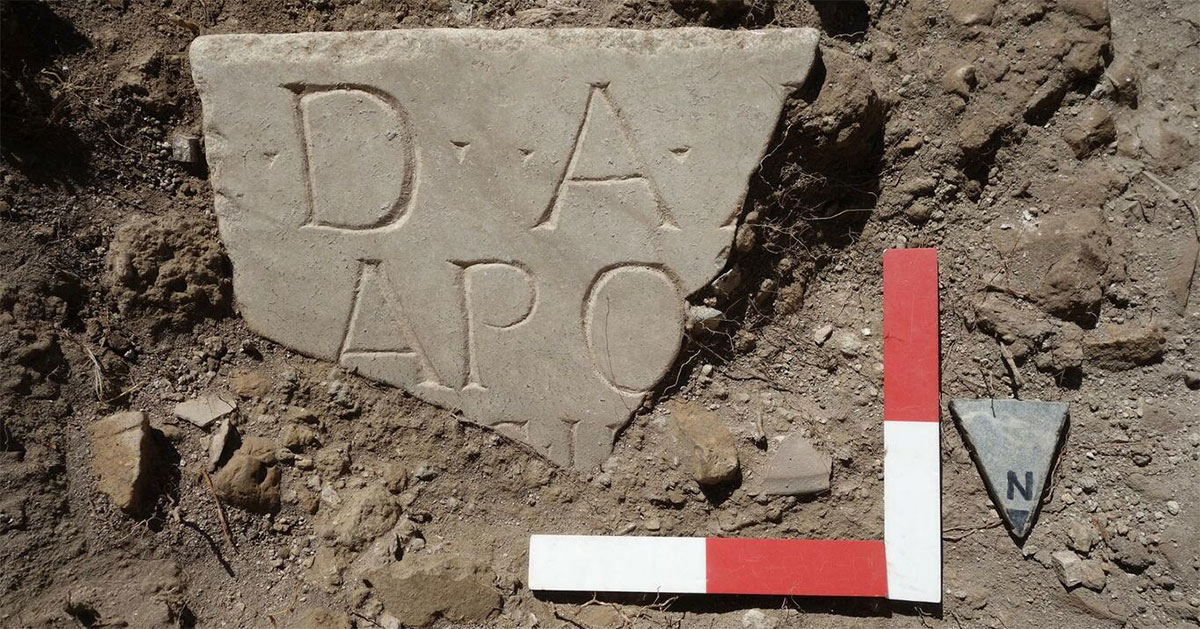Endangered marble cladding: Berlin archaeologists have been working in Ostia for ten years. A workshop report about the rescue attempt of the Roman colony. Report published in Der Tagesspiegel on 16-04-2019
By Axel Gering

Ostia and Portus, once the most important port cities of Rome, have been silted up for centuries by the slow-flowing Tiber. Where ships were once safely anchored, today the allotments are spread all over the fertile Tiber sediment. But the Roman ruins were never completely forgotten, especially because the Capitol, the most important temple of the first colony of Rome, always stood prominently above the ancient monotonous wetlands.
The investigation of all ancient remains in the centre of the old port city of Ostia has been the goal of the Ostia Forum Project of Humboldt University for more than ten years. Since 2008, annual excavation campaigns have been taking place in collaboration with, among others, the Soprintendenza archeologica of Rome and Ostia, the University of Aarhus and the FU Berlin. In addition, the old excavations from the end of the 18th century are documented for the first time by means of the latest techniques, previously neglected areas are excavated and all finds are reconstructed in their historical context. For the first time the development of the first colony of Rome can be fully followed till the end of antiquity.
Once the flagship project of Mussolini
Excavations have been carried out in Ostia for more than three centuries. Only after the persistent malaria in the marsh area was successfully combated in the early 20th century, the Italian archaeologist Dante Vaglieri and his dedicated assistant Raffaele Finelli started meticulous, systematic excavations. These were taken over by the fascist regime in Italy from 1921, expanded and soon deckared Benito Mussolini's flagship project.
Ostia, which illustrates life in an ancient city with apartment buildings up to six floors at the time, became an example of fascist housing construction in Italy. After 1945, however, due to the changed political situation, it became quiet in the antique city. Only since 1991 international excavation teams disturbed the peace again around the ruins, idyllically integrated into a shady pine forest - which was still dating from the fascist era.

But nature and culture cannot always go together without risk. The roots of shadow giving trees, especially cypresses and pines, which are for the shade welcome by all excavators, also destroy irreparable cultural heritage. Ostia, once a cosmopolitan port city and trade center in the heart of the Roman Empire, is considered to be the city with the most marble inscriptions and statues of the Roman world, outside the capital Rome itself.
The world's largest excavated Roman city

This turns out to be a major problem today - but also an opportunity: nowhere else you can make sensational discoveries that have escaped the excavators of the past, without having to move a lot of soil yourself, by carefully examining just a few centimeters of those "forgotten "layers.
But how can one preserve the cultural heritage of an entire city, dug up long ago but never scientifically documented? Nowadays, cultural heritage sites are often seen as a landscape park where nature and culture must be preserved next to each other. You may wonder if you need still archeology for that? However, documentation of these sites for historical knowledge for future generations can only be done through active archaeological research with specific methods using the most modern means of excavation and documentation technology.
Additional damage due to growing visitor flows
The modern visitor to Ostia walks directly over the street level of the old town, usually regardless of its age and vulnerability. Damage is not only applied to mosaics or marble floors, but especially also to the inconspicuous surfaces of the soil or cement soil layers 'forgotten' in old excavations, where coins and other finds are still in their old position. If this original layer is destroyed, the architectural and cultural significance of the artifacts is irreversibly lost. The number of visitors is increasing every year. The collateral damage, however, mainly occurs on the main routes of increasingly channeled tourism.
Conservative measures with modern materials often prove counterproductive. The vegetation is also difficult to control, roots, erosion and carelessness destroy the soil formations and the still standing walls. Is it possible to prevent the irreversible loss of this unique evidence of ancient life? The only complete protection would be to completely clear the site from vegetation and visitors. But from the didactic value of the site alone, this is of course not an option for the antique authorities: in addition to travelers there are many school classes, for which this is often their first contact with the basic of present-day Europe, Roman civilization
Virtual rescue in the 3D model
And this is where archeology comes into play again. With micro-archaeological methods that enable maximum knowledge enrichment. With minimal interventions in the earth's surface, previously excavated sites can also be treated according to the latest state of excavation technology and subsequently digitally documented in high resolution. This allows at least virtual preservation of the status quo of all soils against future damage.
Such preventive documentation is provided by the Ostia Forum project, especially in the case of expected "loss points" of the old findings along the most popular tourist routes. Every year, soils are freed from the roots, dug up and documented in detail. All archaeological finds, including scientific information, such as soil samples, are currently being integrated into a three-dimensional standard model of the center of the ancient city. Thanks to funding from the Humboldt University Foundation (SHU), we can still continue with this method of documentation up to 2022.

Nine hundred years of urban development in the center of Rome's first colony suddenly become visible in this way: from the earliest temples that shed new light on the cultural policy of Rome itself, to the history of the fall of Ostia that came much later than Rome but also ended more catastrophically than previously suspected.
An earthquake and tsunami could have destroyed Ostia
There are strong indications that Ostia's marble and a large part of the population went down due to a sea and earthquake disaster in 443 AD. The relatively new archaeo seismology, for example, helps with the reconstruction of previously unknown historical earthquakes. Based on measurable damage patterns, earthquakes can serve as an indication of what the residents have done after such a catastrophe, restored, rebuilt or abandoned a building. Anti-seismological construction work is currently being investigated for the first time by analyzing walls of 2,000-year-old buildings. Soil samples in a sludge layer spread throughout the city demonstrated in 2018 that it was not caused by an annual flood of the Tiber, but by a tidal wave coming from the sea. This is proven by marble fragments found in the clay during the last excavations.

The research does not end on the spot. The evaluation of the excavation data and soil samples, without which neither the earthquakes nor the tsunami can be converted from disputable hypotheses into historical realities, is the result of a teamwork of several disciplines. Today, archeology, with its collaborations and opportunities for knowledge, goes far beyond the boundaries of the humanities and combines this with natural science and 3D technology to form a common view of our cultural history.
- Notes
- 1:The author is Stiftungs-Sonderprofessor at the Winckelmann Institute for Classical Archeology at Humboldt University in Berlin and leads the Ostia-Forum-Project






 We are committed to providing versions of our articles and interviews in several languages, but our first language is English.
We are committed to providing versions of our articles and interviews in several languages, but our first language is English.